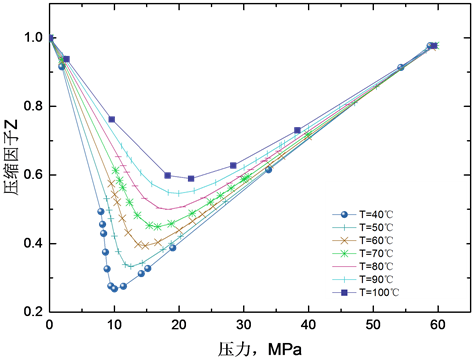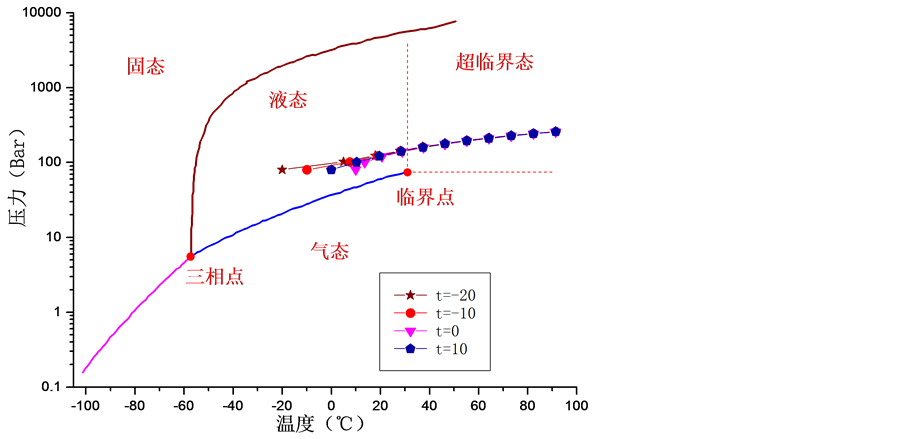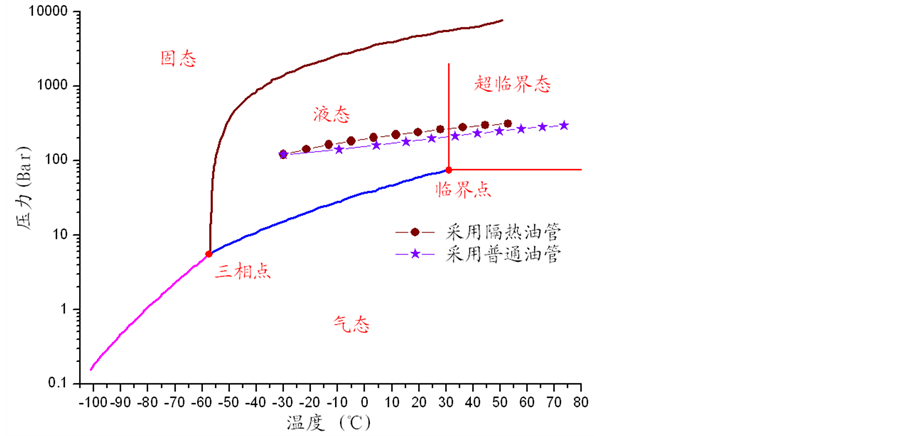摘要: 由于CO
2在油藏流体中具有降低原油粘度和界面张力的特性,因此现场采用注CO
2混相/非混相驱的办法来提高原油采收率。随着CO
2驱油技术应用的不断深入,如何快速准确地判定在不同注入参数下CO
2在注入井筒中沿井筒温度、压力及相态分布特征,以避免注入过冷CO
2液体对地层造成冷伤害,获得最大的驱油效果是CO
2注入工艺和开发设计亟待解决的问题。本文在综合考虑CO
2压缩因子、比热容及粘度等参数计算的基础上,建立注CO
2井井筒温度、压力计算模型。对M油田注CO
2气井模拟计算结果与实测结果对比表明,该模型能够较好的应用于CO
2注入井的井筒温度压力模拟计算,其计算结果可为CO
2驱注入工艺及开发设计提供理论依据。
Abstract:
Because CO2 within the reservoir fluid has the characteristics of reducing the viscosity and interfacial tension of the oil, CO2 miscible or immiscible flooding is used in the field to enhance oil recovery. With the development of the application of CO2 flooding technology, there exists an urgent problem in CO2 injection process and developing design: how to estimate the temperature, pressure and phase distribution of CO2 in the wellbore under different injection parameters quickly and accurately, in order to avoid the cold damage to the formation caused by injecting supercold liquid CO2, and get the maximum flooding effect. Based on the consideration of CO2 compression factor, specific heat capacity and viscosity, this paper established a model to calculate the temperature and pressure of CO2 injection wells. Comparing the simulation results of CO2 gas wells in oil field M with the measured, it indicates that the model can be commendably applied to calculate the wellbore temperature and pressure of CO2 injection well. The calculation results can provide the theoretical basis for CO2 flooding process and developing design.
1. 引言
注CO2驱已经广泛应用于油层提高采收率 [1] 。影响CO2注入效果及提高采收率的关键因素之一是注入井井底温度压力及CO2存在状态 [2] ,从而影响CO2在储层中和原油接触的压力。由于CO2的物性特点,在注入过程中存在复杂的变化过程,明确注CO2井井筒温度压力特点为注气井设计提供合理依据。本文基于井筒传热及流动规律,结合CO2压缩因子、粘度和比热容等参数计算基础上,分析注CO2井井筒剖面温度压力及物性变化规律。
2. 井筒流动与传热数学模型
2.1. 注入井井筒压降模型
根据动量方程,注CO2井筒综合压降计算模型 [3] 为:
 (1)
(1)
其中, 为CO2的压力,Pa;
为CO2的压力,Pa; 为CO2流过的管长,m;
为CO2流过的管长,m; 两相摩阻系数,无因次,由Churchill方程 [4] 确定;
两相摩阻系数,无因次,由Churchill方程 [4] 确定; 为CO2在管道内的平均流速,m/s;
为CO2在管道内的平均流速,m/s; 为管内径,m;
为管内径,m; 为两相流动密度,kg/m3;
为两相流动密度,kg/m3; 重力加速度常数,
重力加速度常数, 为管线与水平面间的夹角。
为管线与水平面间的夹角。
2.2. 注入井筒热传递数学模型
根据能量守恒原理得:
 (2)
(2)
其中, 为流体温度,℃;z为从地表向下算起的距离,m;
为流体温度,℃;z为从地表向下算起的距离,m; 为流体比焓,J/mol;
为流体比焓,J/mol; 为流体与周围地层的换热量,kJ;
为流体与周围地层的换热量,kJ; 为流体压力,MPa;v为流体流速,m/s;
为流体压力,MPa;v为流体流速,m/s; 为转换系数,W/(m2∙K);
为转换系数,W/(m2∙K); 为热功当量,W/(m2∙K);
为热功当量,W/(m2∙K); 为焦耳-汤姆逊系数,无因次;
为焦耳-汤姆逊系数,无因次; 为恒压下平均热容量,J/(kg∙K)。
为恒压下平均热容量,J/(kg∙K)。
由油管内CO2到地层界面的传热速率 [6] 为:
 (3)
(3)
式中:总传热系数 可以由计算公式得出,W/(m2∙K);
可以由计算公式得出,W/(m2∙K); 为油管的外半径,m.;
为油管的外半径,m.; 为井筒中流体温度,℃;
为井筒中流体温度,℃; 为井筒与地层界面温度,℃;
为井筒与地层界面温度,℃; 为流体质量流量,kg/s。
为流体质量流量,kg/s。
由地层界面向地层传热 [6] 为:
 (4)
(4)
式中, 为无因次瞬态传热函数,由经验公式chiu [5] 可得;
为无因次瞬态传热函数,由经验公式chiu [5] 可得; 为地层的热传导系数,J/(s·m·K);
为地层的热传导系数,J/(s·m·K); 为未受影响的地层温度,℃。
为未受影响的地层温度,℃。
结合(3)、(4)两式,消去 得:
得:
 (5)
(5)
假定地层温度与深度呈线性关系,即:
式中: —地热梯度,℃/m;
—地热梯度,℃/m; —井底地层温度,℃。
—井底地层温度,℃。
代入(2)得:
 (6)
(6)
其中:
依据Ramey公式 [6] 计算单位面积井筒总传热系数可表示为:
 (7)
(7)
式中: 为油管中流体与油管壁间的传热系数,W/(m2·℃);
为油管中流体与油管壁间的传热系数,W/(m2·℃); 为环空流体辐射传热系数,W/(m2·℃);
为环空流体辐射传热系数,W/(m2·℃); 为环空流体对流传热系数,W/(m2·℃);
为环空流体对流传热系数,W/(m2·℃); 为油管内半径,m;
为油管内半径,m; 为油管外半径,m;
为油管外半径,m; 为油管内壁温度,℃;
为油管内壁温度,℃; 为油管外壁温度,℃;
为油管外壁温度,℃; 为油管导热系数,W/( m·℃);
为油管导热系数,W/( m·℃); 为套管外半径,m;
为套管外半径,m; 为套管内半径,m;
为套管内半径,m; 为套管内壁温度,℃;
为套管内壁温度,℃; 为套管外壁温度,℃;
为套管外壁温度,℃; 为套管导热系数,W/ m.℃;
为套管导热系数,W/ m.℃; 为水泥环外半径(裸眼半径),m;
为水泥环外半径(裸眼半径),m; 为套管外水泥环、地层交界面之间温度,℃;
为套管外水泥环、地层交界面之间温度,℃; 为水泥环导热系数,W/ m.℃;
为水泥环导热系数,W/ m.℃;
其中 ,
, 由G. Paul,Willhite提出的传统计算方法计算。
由G. Paul,Willhite提出的传统计算方法计算。
3. CO2井筒内参数计算
3.1. 压缩因子的计算方法
处于油田井筒注入情况下的二氧化碳属于非理想气体,采用Lee-Kesler对比态状态方程(简称为L-K方程)描述 [7] 。其压缩因子方程表述为:
 (8)
(8)
其中 分别为简单流体、参考流体和实际流体的压缩因子,
分别为简单流体、参考流体和实际流体的压缩因子, 分别为实际计算流体和参考流体的偏心因子。根据基本参数 [7] 计算得到CO2的压缩因子随压力变化情况见图1,压缩因子随着压力先增大后降低。在相同压力条件下,温度越高,压缩因子越大。但在10~20 MPa内CO2的压缩因子很小,具有较强的可压缩性。
分别为实际计算流体和参考流体的偏心因子。根据基本参数 [7] 计算得到CO2的压缩因子随压力变化情况见图1,压缩因子随着压力先增大后降低。在相同压力条件下,温度越高,压缩因子越大。但在10~20 MPa内CO2的压缩因子很小,具有较强的可压缩性。
3.2. CO2比热容计算方法
(1)液态CO2的比热容
根据CO2在井筒中相态的不同,采用不同的比热容公式计算。本发明中采用Lyman-Danner方程 [7] 计算液态CO2的比热容:
 (9)
(9)
式中, 为液态CO2的比热容,cal∙gmol−1∙K−1,
为液态CO2的比热容,cal∙gmol−1∙K−1, 为理想气体比热容,cal∙gmol−1∙K−1;T为温度,K,A,B,C,D为与气体性质相关的常数;A1~A8,B1~B5为Lyman-Danner方程常数 [7] ;κ为缔合因子,对于CO2取值为7.3589;
为理想气体比热容,cal∙gmol−1∙K−1;T为温度,K,A,B,C,D为与气体性质相关的常数;A1~A8,B1~B5为Lyman-Danner方程常数 [7] ;κ为缔合因子,对于CO2取值为7.3589; 为回转半径,对于CO2取值为0.9918。
为回转半径,对于CO2取值为0.9918。
(2)气态和超临界态CO2的比热容
气态和超临界态CO2的比热容计算采用实际气体比热容计算式:
 (10)
(10)
式中, 为剩余比热容,cal∙gmol−1∙K−1。
为剩余比热容,cal∙gmol−1∙K−1。
3.3. CO2粘度计算
基于PR EOS状态方程建立的CO2粘度计算模型 [8] ,该模型能够用于描述气、液相及超临界状态流体的粘度的变化。
 (11)
(11)

Figure 1. Variation of CO2 compression factor with pressure
图1. CO2压缩因子随压力变化
其中,





而

如图2所示,模拟计算表明:CO2处于液态时,粘度随着温度压力的增加而增加,而处于超临界状态时,压力不变条件下,粘度随温度增加而减小,而温度一定条件下,粘度随压力增加而增加。
4. 计算实例
M油田B井区自2010年4月份开展注CO2先导试验。地表年平均温度3℃~6℃,低温梯度为4.2℃/100 m。B井为注CO2直井,最大井斜1.4度。油层套管外径139.7 mm,内径121.36 mm。采油管柱采用非隔热BGT气密封油管,油管外径73 mm,内径62 mm,管柱长度2321.44 m。油管外采用封隔器密封,座封深度2209 m,环空采用水基缓释液防腐。单井地面注气压力为12.5 MPa,日注CO2 40 t/d,注气温度为10℃。
通过模拟计算得到井底压力和温度值如表1,部分井实测值对比结果如下表。压力和温度的最大误差分别为4.62%和3.04%,表明本计算方法能够较好的应用于模拟计算不同注入参数下的井筒内温度和压力的分布状况。

Figure 2. Variation of CO2 viscosity with pressure
图2. CO2粘度随压力变化
4.1. 注CO2井筒相态分布
将模拟计算得到的井筒温度、压力分布状况绘制到CO2P-T相图如图3所示。从图3可以看出,在井口注入压力为12.5 MPa,日注量为40 m3/d的条件下,CO2在井筒中起初为液态,到达450 m以后相态转为超临界态,井筒流体处于增压过程,密度由909.25 kg/m3增加。在井深到达450米时,CO2处于超临界状态,此时密度最大为921.37 kg/m3,随后CO2密度沿井筒向下逐渐减小,到达底层时密度为800.95 kg/m3 (图4)。
4.2. 注入压力对注气效果的影响
为了分析井口注入压力的影响,取注气量为12 t/d固定不变,改变注气压力进行模拟计算(分别取为4、8、12、16 MPa),将这四种条件下的计算结果绘制到图5,从图5中可以看出,在这几种注入压力下,CO2沿井筒注入过程中相态变化规律均为由液态逐渐转变为超临界状态(在井底为超临界状态,有利于提高注入性和采收率 [1] )。随着井口注入压力的增大,井底压力也随之增大,且CO2压缩性相对越强。

Table 1. Pressure and temperature profile of well B
表1. B井压力、温度对比表

Figure 3. Phase diagram of the CO2 injection
图3. 注CO2井筒相态分布
4.3. 注入温度对注气效果的影响
为了分析井口注入温度对注气效果的影响,取注气量为12 t/d固定不变,在注气压力8 MPa条件下,改变注气温度进行模拟计算(分别取为−20、−10,0、10℃),将这四种条件下的计算结果绘制到图6。从图6中可以看出,尽管井口处温度差异大,但由于井筒传热系数大,井筒温度能迅速与储层平衡。虽然井口注入温度各不相同,但在井底处温度接近,均达到91℃,不会对储层造成冷伤害。该计算结果表明在注CO2驱提高采收率过程中,井口可以采用不加热直接注入的工艺方式注入CO2,其结果也不会对储层造成冷伤害。依据该计算结果可以简化注入流程,节省了现场注气加热工艺,从而可节约注气成本。
4.4. 隔热管柱对注气效果的影响
对比模拟分析注气量为48 T/d,注气压力12 MPa时,模拟采用隔热与不隔热油管条件,这两种计算结果绘制到图7。从图7中可以看出,与常规油管相比,采用隔热油管时,从井筒周围储层吸热量少,温度偏低,可能存在对储层的冷伤害。依据该计算结果可指导现场在注CO2驱提高采收率过程中,注气

Figure 4. Density profile of CO2 injection in B well
图4. B井CO2注入井筒密度分布

Figure 5. PT profile at different gas injection pressures
图5. 不同注气压力时PT分布

Figure 6. PT profile at different gas injection temperature
图6. 不同注气温度时PT分布

Figure 7. PT profile at different gas injection pressures
图7. 不同注气管柱结构的PT分布
管柱可直接采用光油管注气的工艺方式,从而可节约管柱成本。
5. 小结
(1) 采用本算法模拟得到井筒温度压力的分布和实际符合程度较高,误差范围小于5%,能够较好的应用于现场CO2注气井的井筒温度压力剖面的预测分析,为现场注入设计提供参考。
(2) CO2处于液态时,粘度随着温度、压力的增加而增加。而处于超临界状态时,压力不变条件下,粘度随温度增加而减小;当温度一定条件下,粘度随压力增加而增加。
(3) 在注气温度为−20~10℃范围内,井口注气温度变化对井底温度影响很小,该计算结果可以指导现场简化注入流程,节省现场注气加热工艺,节约注气成本。
(4) 隔热油管降低储层和井筒内传热,相同井口注气温度条件下,采用隔热油管不利于注气井底温度的增加。因此,现场在注CO2驱提高采收率过程中,可以采用光油管注气的工艺方式进行注气。